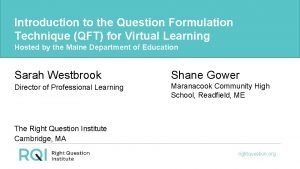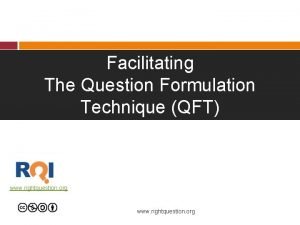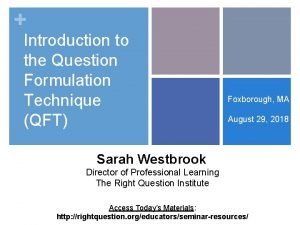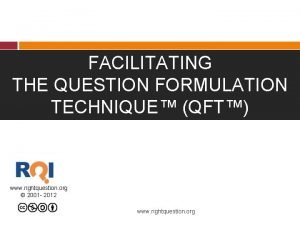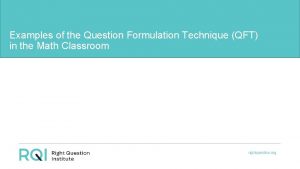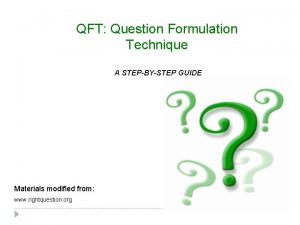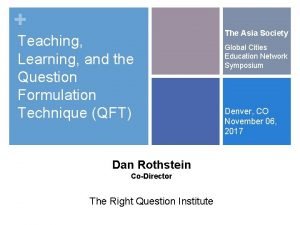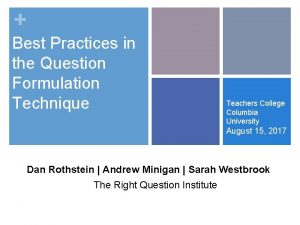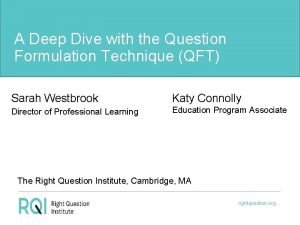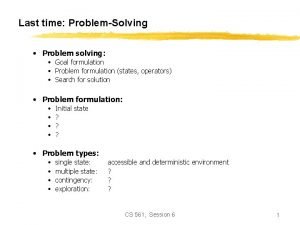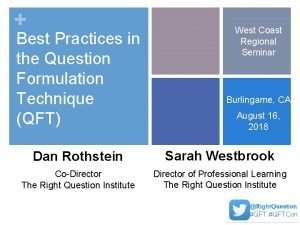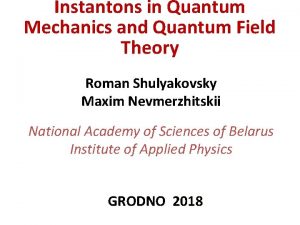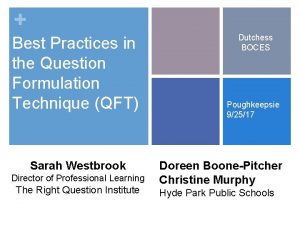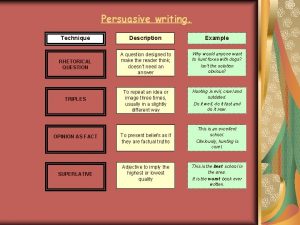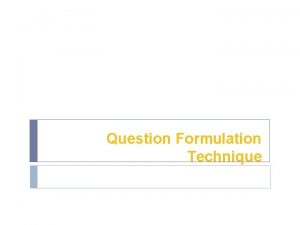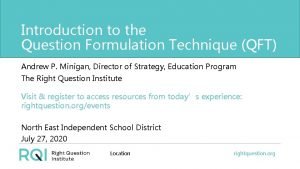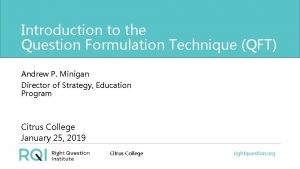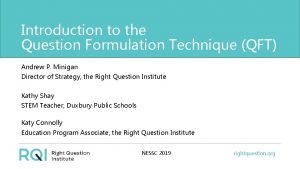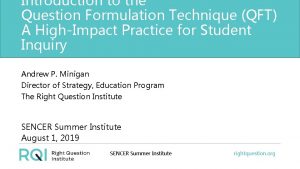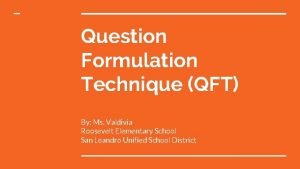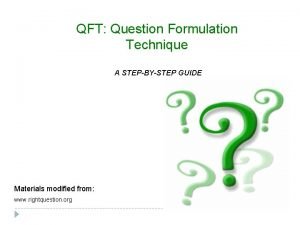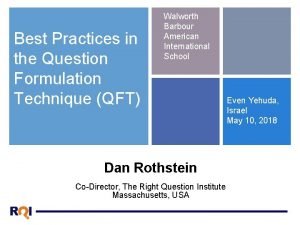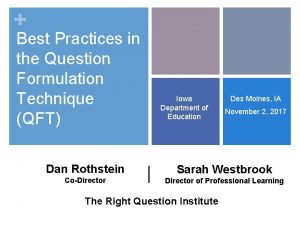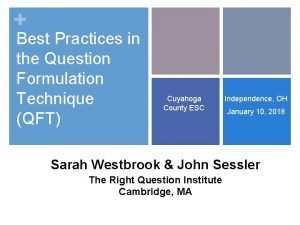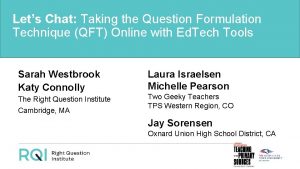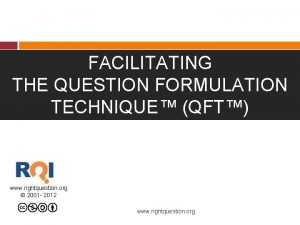Introduction to the Question Formulation Technique QFT for



































































- Slides: 67

Introduction to the Question Formulation Technique (QFT) for Primary Source Learning Hosted by the Library of Congress Teaching with Primary Sources Program Sarah Westbrook Andrew Minigan Director of Professional Learning Director of Strategy The Right Question Institute Cambridge, MA rightquestion. org

There are 2 icons you will see in this session: This means that you should be thinking or working on the task assigned This means get ready to use your chat box to share some of your work

Who is in the room? (Not this room, but rather our virtual version of the Library of Congress!) Highsmith, C. M. , photographer. Reading Room at the Library of Congress's historic Thomas Jefferson Building, Washington, D. C. United States Washington D. C, None. [Between 1980 and 2006] [Photograph] Retrieved from the Library of Congress, https: //www. loc. gov/item/2011635726/

Today’s Agenda 1) Why Spend Time on Teaching the Skill of Question Formulation? 2) Collaborative Learning with the Question Formulation Technique (QFT) 3) Explore Real Classroom Examples & Applications 4) Why is Question Formulation Important Now? 5) Q&A

We’re Tweeting… @Right. Question @Andrew. RQI @Sarah. RQI #QFT

Access Today’s Materials and All of Our Free Resources https: //rightquestion. org/events/ Classroom Examples Instructional Videos Planning Tools & Templates

Use and Share These Resources The Right Question Institute offers materials through a Creative Commons License. You are welcome to use, adapt, and share our materials for noncommercial use, as long as you include the following reference: “Source: The Right Question Institute (RQI). The Question Formulation Technique (QFT) was created by RQI. Visit rightquestion. org for more information and free resources. ”

+ Why spend time teaching the skill of question formulation?

Honoring the Original Source: Parents in Lawrence, MA 1990 “We don’t go to the school because we don’t even know what to ask. ”

“There can be no thinking without questioning—no purposeful study of the past, nor any serious planning for the future. ” – David Hackett Fischer University Professor Emeritus of History, Brandeis University

“Libraries allow children to ask questions about the world and find the answers. And the wonderful thing is that once a child learns to use a library, the doors to learning are always open. ” – Laura Bush Educator & Former First Lady of the United States

“We must teach students how to think in questions, how to manage ignorance. ” – Stuart Firestein Former chair, Department of Biology, Columbia University

College Presidents on What College Students Should Learn “We are here to ask questions—questions about one another and about the world around us. We are at Yale to nurture a culture of curiosity. ” - Peter Salovey, President of Yale University https: //president. yale. edu/speeches-writings/speeches/culture-curiosity “…the best we can do for students is have them ask the right questions. ” - Nancy Cantor, Former Chancellor of University of Illinois The New York Times, August 4, 2002

Yet, Only 27% of Graduates Believe College Taught Them How to Ask Their Own Questions Alison Head, Project Information Literacy at University of Washington, 2016

But, the problem begins long before college…

Age Four: “The true age of inquisitiveness” • James Sully dubbed age four, “the true age of inquisitiveness when question after question is fired off with wondrous rapidity and pertinacity. ” • Young children ask 10, 000 questions per year before they begin formal schooling. Sully, 1896 Harris, 2012

Question Asking by Adolescence Who’s asking questions over the course of an hour? Educators Students Dillon, 1988, p. 199

Educators Recognize the Problem • Teachers report that getting students to ask questions feels like, “pulling teeth. ” • Students ask less than 1/5 th the questions educators estimated would be elicited and deemed desirable. Susskind, 1979

How can teaching students to ask questions go from a feeling of “pulling teeth” to a feeling of excitement for both teachers and learners?

Moving from the exception… In a 1912 study Romiett Stevens observed: “an unusual lesson because twenty-five of the thirtyfour questions were asked by the pupils… The result was that the lesson developed an impetus born of real interest. I mention it because this lesson was unique in the series of one hundred. ” The question as a measure of efficiency in instruction: A critical study of classroom practice. Columbia University Contributions to Education, No. 48

To the Norm More than 1 million classrooms worldwide

What happens when students do learn to ask their own questions?

Research Confirms the Importance of Questioning Self-questioning (metacognitive strategy): • Student formulation of their own questions is one of the most effective metacognitive strategies • Engaging in pre-lesson self-questioning improved students rate of learning by nearly 50% (Hattie, p. 193) John Hattie Visible Learning: A Synthesis of Over 800 meta-Analyses Relating to Achievement, 2008

Student Reflection “The way it made me feel was smart because I was asking good questions and giving good answers. ” -Boston 9 th grade summer school student

Student Reflection “The QFT really teaches a way of thinking so students can be thinking critically every time they read, trying to connect the concepts and deciding whether to take facts and information at face value or to dig a little deeper. ” - Student, Brandeis University

+ Collaborative Primary Source Learning with the Question Formulation Technique (QFT)

The Question Formulation Technique (QFT) Individuals learn to: § Produce their own questions § Improve their questions § Strategize on how to use their questions § Reflect on what they have learned and how they learned it

Rules for Producing Questions 1. Ask as many questions as you can 2. Do not stop to answer, judge, or discuss 3. Write down every question exactly as stated 4. Change any statements into questions

Produce Questions 1. Ask Questions 2. Follow the Rules • Ask as many questions as you can. • Do not stop to answer, judge, or discuss. • Write down every question exactly as it was stated. • Change any statements into questions. 3. Number the Questions

Question Focus Some students are not asking questions about primary sources. Ask questions. Number the questions. Follow the rules.

Categorize Questions: Closed/Open Definitions: • Closed-ended questions can be answered with a “yes” or “no” or with a one-word answer. • Open-ended questions require more explanation. Directions: Identify your questions as closed-ended or openended by marking them with a “C” or an “O. ”

Discuss Closed-ended Questions Advantages Disadvantages

Discuss Open-ended Questions Advantages Disadvantages

Improve Questions • Take one closed-ended question and change it into an openended question. Closed Open • Take one open-ended question and change it into a closedended question. Open Closed

Prioritize Questions Review your list of questions • Choose three questions that you are most curious to discuss and think about further. • While prioritizing, think about your Question Focus, Some students are not asking questions about primary sources. • Then, think about why you chose those questions. After prioritizing, use the chat box to share ONE of your priority questions.

Action Plan Moving from priority questions into action steps. In order to answer your priority questions: • What do you need to know? Information • What do you need to do? Tasks Write down a couple ideas you have.

Share Using the Chat Box, please share: 1. One idea you had from your action plan - and - 2. The numbers of your three priority questions in your original sequence (For ex: “ 2, 4, 7 out of 8 total”)

Reflect • What did you learn? • How did you learn it? After reflecting, use the chat box to share your response to ONE of the questions above.

A Look Inside the Process

The QFT, on one slide… 1) Question Focus 2) Produce Your Questions ü Follow the rules ü Number your questions 1. 2. 3. 4. Ask as many questions as you can Do not stop to discuss, judge or answer Record exactly as stated Change statements into questions 3) Improve Your Questions ü Categorize questions as Closed or Open-ended ü Change questions from one type to another 4) Strategize ü Prioritize your questions ü Action plan or discuss next steps ü Share 5) Reflect Closed-Ended: Answered with “yes, ” “no” or one word Open-Ended: Require longer explanation Source: The Right Question Institute rightquestion. org

Three thinking abilities with one process

Thinking in many different directions Divergent Thinking

Narrowing Down, Focusing Convergent Thinking

Thinking about Thinking Metacognition

+ Exploring Classroom Examples

Classroom Example: High School Teacher: Kelly Grotrian, East Brunswick, NJ Topic: 11 th Grade U. S. History Purpose: To conclude a unit on World War II and lead into an informed debate about US use of atomic weapons

Question Focus http: //www. loc. gov/pictures/item/98506956/

Student Questions 1. 2. 3. 4. What is this? Who did this? How did this affect people? What were the environmental & economic implications of dropping the bomb? 5. How many people were hurt? 6. Is that a plane wing in the bottom right? 7. Did the people in that plane drop the bomb? 8. Did the people dropping the bomb know what they were doing? 9. Did they make the bomb? 10. Who was responsible for dropping the bomb? 11. What led to this event? 12. What happened as a result of dropping the bomb? 13. Where was the bomb dropped? 14. Had people been given warning? 15. How long did it take to notice effects of the bomb? 16. When did this happen (at what point in the war)? 17. How many lives were lost as a result?

Next Steps: § Students chose priority questions to respond to in a homework assignment that night § Homework and subsequent lessons lead into a debate about whether the United States was justified in dropping the atomic bomb

Virtual Classroom Example: 4 th Grade Social Studies Teacher: Alyssa Park, Gardnerville, NV Topic: The Hoover Dam Purpose: To analyze a primary source and launch a mini -inquiry – using Google Forms!

Question Focus Library of Congress: https: //www. loc. gov/resource/cph. 3 b 07810/

Question Focus…using Prezi! Library of Congress: https: //www. loc. gov/resource/cph. 3 b 07810/

Student Questions 1. Where is this? 2. Why is there a river? 3. Is it a desert? 4. Is it near the grand canyon? 5. When was this picture taken? 6. How did they take the picture? 7. Was it in the 1900's? 8. Where does the road lead to? 9. What is the road called? 10. Is the sculpture (or whatever it is) in the middle of the road a rock? 11. Where is the building located? 12. Do people live in that building? 13. Is it a work place? 14. Is there water at the bottom of the building? 15. Is the road from the last picture lead to the building? 16. How did they build that building? 17. How do people get to the top to the bottom? 18. Is the water falling from the rocks a waterfall? 19. Can people visit the building? 20. How does the water get there?

Student Questions…using Google Forms! Students entered their questions in a google form, which populated a google sheet they could use to categorize their questions as open and closed.

Next Steps Days 1 -3 Using google forms and google sheets Ask & Improve Questions Day 4 Gather Basic Information Day 5 Prioritize Questions (Again!) Days 6 & 7 Further Research Students picked 3 closed-ended questions to answer Read from a collection of 4 th grade, Hoover Dam books on Epic! Shared answers in a collaborative google slide deck Pick from the whole class list: 3 questions you would need to answer to write a historical fiction story on the Hoover Dam. They will spend time looking through a “playlist” of resources categorized by the major themes – how dams work, life during the great depression, etc. and answer their second set of priority questions.

Virtual Professional Learning Example • Topic: Japanese American Internment primary sources • Purpose: A live webinar introducing educators to using the QFT with primary sources during distance learning using Padlet.

Question Focus Lange, Dorothea. (1942) Oakland, CA, Mar. 1942. A large sign reading "I am an American" placed in the window of a store on December 8, the day after Pearl Harbor. The store was closed following orders to persons of Japanese descent to evacuate from certain West Coast areas. [Photograph] Retrieved from the Library of Congress, https: //www. loc. gov/pictures/resource/ cph. 3 a 24566/.

Selected Questions • Are there other images that Lange took in Oakland on that day? • Did Dorothea Lange happen upon this site or was she prompted to go there and take the photo? • How did photography change or influence public opinion about Japanese Americans? • Why do they need to claim they are American? • What makes someone American? • Has anything changed in our reactions to “foreigners” or has it just shifted slightly? • Does ”Americanness” need to be performed in some way to be valid? • What happened to the store owner after this photo was taken? • Who is the "I? ” • How significant is the car? • What message is the store owner trying to relay to the community by posting the sign? • How did other business owners in the area react to this action? • What may the shop owner fear if it prompted them to hang that sign in the aftermath of Pearl Harbor? • Did the owners already experience some negative reactions, or was this in anticipation? • Was it done out of patriotism or fear? • Did all Japanese Americans relocate? What were the consequences of resistance?

What do I do with the questions students produce? Ø Students can look for answers to their priority questions (and generate new questions) through researching Library of Congress collections of Japanese American Internment primary sources: o o o http: //www. loc. gov/teachers/classroommaterials/primarysourcesets/internment/ A primary source set on Japanese American internment with teacher’s guide Women Come To the Front - Dorothea Lange: https: //www. loc. gov/exhibits/wcf 0013. html https: //blogs. loc. gov/picturethis/2015/02/day-of-remembrance-photographs-of-japaneseamerican-internment-during-world-war-ii/ blog post that links resources throughout Library collections Ø Lead students through primary source analysis using the TPS “Observe – Reflect – Wonder” tool, starting with their priority questions. Then, see what questions remain, or what new ones have been generated.

Make Your Own Padlet Access the QFT Padlet Template Here: https: //padlet. com/sarahwestbrook 1/QFT 2 Access a quick guide to using Padlet: https: //rightquestion. org/remote-learningresources/

Why is the skill of question formulation so important now?

In the Age of Google “How should you respond when you get powerful new tools for finding answers? Think of harder questions. ” – Clive Thompson Journalist and Technology Blogger

Questions and Democracy “We need to be taught to study rather than to believe, to inquire rather than to affirm. ” – Septima Clark Chapter 6 on Septima Clark in Freedom Road: Adult Education of African Americans (Peterson, 1996)

What are your questions for us?

Before You Go Please take our survey https: //www. surveymonkey. com/r/2020_LOC_Webinar Certificates for Live Participation Only Email kmcg@loc. gov

Thank you! Enjoy! rightquestion. org

Using & Sharing RQI’s Resources The Right Question Institute offers materials through a Creative Commons License. You are welcome to use, adapt, and share our materials for noncommercial use, as long as you include the following reference: “Source: The Right Question Institute (RQI). The Question Formulation Technique (QFT) was created by RQI. Visit rightquestion. org for more information and free resources. ” Access today’s materials (and more!): http: //rightquestion. org/events/
 Question formulation technique
Question formulation technique Qft technique
Qft technique Question formulation technique pdf
Question formulation technique pdf Question formulation technique worksheet
Question formulation technique worksheet Qft examples
Qft examples Question formulation technique worksheet
Question formulation technique worksheet Qft questioning
Qft questioning Question formulation technique examples
Question formulation technique examples Qfocus examples
Qfocus examples Why problem formulation follow goal formulation
Why problem formulation follow goal formulation What is qft
What is qft Qft questioning
Qft questioning Qft
Qft Qft protocol
Qft protocol Examples of level three questions
Examples of level three questions Example of rhetorical question
Example of rhetorical question Fspos
Fspos Typiska novell drag
Typiska novell drag Tack för att ni lyssnade bild
Tack för att ni lyssnade bild Ekologiskt fotavtryck
Ekologiskt fotavtryck Varför kallas perioden 1918-1939 för mellankrigstiden
Varför kallas perioden 1918-1939 för mellankrigstiden En lathund för arbete med kontinuitetshantering
En lathund för arbete med kontinuitetshantering Underlag för särskild löneskatt på pensionskostnader
Underlag för särskild löneskatt på pensionskostnader Personlig tidbok
Personlig tidbok Anatomi organ reproduksi
Anatomi organ reproduksi Vad är densitet
Vad är densitet Datorkunskap för nybörjare
Datorkunskap för nybörjare Boverket ka
Boverket ka Mall för debattartikel
Mall för debattartikel Magnetsjukhus
Magnetsjukhus Nyckelkompetenser för livslångt lärande
Nyckelkompetenser för livslångt lärande Påbyggnader för flakfordon
Påbyggnader för flakfordon Vätsketryck formel
Vätsketryck formel Publik sektor
Publik sektor Kyssande vind analys
Kyssande vind analys Presentera för publik crossboss
Presentera för publik crossboss Argument för teckenspråk som minoritetsspråk
Argument för teckenspråk som minoritetsspråk Vem räknas som jude
Vem räknas som jude Treserva lathund
Treserva lathund Mjälthilus
Mjälthilus Bästa kameran för astrofoto
Bästa kameran för astrofoto Cks
Cks Programskede byggprocessen
Programskede byggprocessen Mat för idrottare
Mat för idrottare Verktyg för automatisering av utbetalningar
Verktyg för automatisering av utbetalningar Rutin för avvikelsehantering
Rutin för avvikelsehantering Smärtskolan kunskap för livet
Smärtskolan kunskap för livet Ministerstyre för och nackdelar
Ministerstyre för och nackdelar Tack för att ni har lyssnat
Tack för att ni har lyssnat Referatmarkeringar
Referatmarkeringar Redogör för vad psykologi är
Redogör för vad psykologi är Matematisk modellering eksempel
Matematisk modellering eksempel Tack för att ni har lyssnat
Tack för att ni har lyssnat Borra hål för knoppar
Borra hål för knoppar Orubbliga rättigheter
Orubbliga rättigheter Beräkna standardavvikelse
Beräkna standardavvikelse Tack för att ni har lyssnat
Tack för att ni har lyssnat Rita perspektiv
Rita perspektiv Ledningssystem för verksamhetsinformation
Ledningssystem för verksamhetsinformation Tobinskatten för och nackdelar
Tobinskatten för och nackdelar Toppslätskivling effekt
Toppslätskivling effekt Gibbs reflekterande cykel
Gibbs reflekterande cykel Egg för emanuel
Egg för emanuel Elektronik för barn
Elektronik för barn Plagg i gamla rom
Plagg i gamla rom Strategi för svensk viltförvaltning
Strategi för svensk viltförvaltning Var 1721 för stormaktssverige
Var 1721 för stormaktssverige Humanitr
Humanitr
